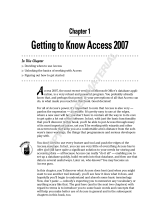Page is loading ...

Change the screen size or close a database
Click the Access icon to resize or move the screen or to close
the database.
Use Controls from the Quick Access Toolbar
You can quickly add or change controls on a form or report by clicking the tools icon when the
form or report is open in Design or Layout view.
File management
Open, close, print, share, save as
previous versions, as a template,
and encrypt or compact and
repair the database.
Status bar
Displays information about the
current view.
Get help
Click the question mark to nd help
content.
Filter objects
Type a keyword into the Search
box to lter objects in the
database.
Views buttons
Click on icons to switch between
available views for the current
object.
Open a dialog box launcher
Click it to use the additional
available features for the group.
Hide the ribbon
Click the up-arrow to hide the
Ribbon but keep the tabs in view.
Quick Start Guide
Microsoft Access 2013 looks different from previous versions, so we created
this guide to help you minimize the learning curve.
Dialog box launchers
If you see this icon
next to any group of
ribbon commands, you
can click it to see a box
with more options.

What can I nd on the
Account tab?
Click File > Account in Access 2013 to manage your user information, change the
background or theme, view and add available web services, display information about
your Ofce products, and manage your product subscriptions.
Where did the Back Up
option go?
It’s always a good idea to back up your important data. To do this in Access 2013,
click File > Save As. Then, under Save Database As > Advanced, click Back Up
Database.

Things you might be looking for
Use the list below to nd some of the more common tools and commands in Access 2013.
To... Click... And then look in the...
Open, close, create, save, print, publish, or manage your database File Backstage view (click the links in the left pane).
View objects, cut, copy or paste data, format text, add a totals row
or nd data
Home Views, Clipboard, Sort & Filter, Records, and Text Formatting groups.
Add application parts, tables, queries, forms, reports, or macros Create Templates, Tables, Queries, Forms, Reports, and Macros & Code
groups.
Bring in les or send data or link to external sources External
Data
Import & Link and Export groups.
Compact and repair a database, work with Visual Basic code, macros,
relationships, and analyze or move data to SharePoint
Database
Tools
Tools, Macro, Relationships, Analyze, and Move Data groups.
View and use the objects in the database Navigation
Pane
All Access Objects group.
Correct le problems or add a password to a database File Info, Compact & Repair, and Encrypt with Password groups.
Create an Access app File New, Custom web app, or web templates options.

What happened to the
Pivot Chart feature?
You can’t create pivot charts or tables in Access 2013, but you can import them
from Excel and other applications and then add them with the Chart control.
Long Text is the new Memo
If you are looking for the Memo data type for longer text elds, try the Long Text
data type instead.
What is an Access app?
Access apps are like web databases that you can use to view and share your data
in the cloud. With Access apps, you’ll have secure, centralized data storage and
management options.
With Access 2013, you can easily create and modify the design of an app. Get
started with an app template or create your own custom web app.
Template names that begin with the word “Desktop“ will create a client database.
To create Access apps, use any template that’s marked with a globe icon.

How to work with people
who don’t yet have Access 2013
Here are some things to keep in mind when sharing or exchanging les with
people who are using an older version of Access.
In Access 2013… What happens? What should I do?
You open a database le
that was created with
Access 2007.
You can use Access 2013 to open and use les that were created in
Access 2007. However, you will not be able to view or use features
like Pivot Tables or conditional formatting.
Import just the tables and then reapply formats in Access 2013.
You save your database
as an Access 2007 le.
You will be able to open and use the database. Nothing.
You save your database
as an Access 2010 le.
Access 2007 and 2010 use the same le format. If you published
an Access 2010 web database and open it in Access 2013, you will
only be able to view it; you will not be able to modify it.
If you published an Access 2010 database as a web database and
want to later change it to an Access app, import the data into
a custom web app.

What’s on the Info tab?
From any open database, click File > Info.
Compact & Repair Database can prevent and x database problems or compact
les to save space.
Files saved in Access 2007 or in a newer format are already encrypted, but you can
add an optional password to further secure your data by clicking Encrypt with
Password.
Clicking View and edit database properties displays information about objects
in the database, revision tracking, and database size. You can also change the
database title, author, company, and hyperlink information from the Summary tab
found here.
Can I convert my Access data-
base into an Access app?
Though Access apps are also used for tracking data, you cannot convert a desktop
database into an Access app or vice versa. However, you can use data from a desk-
top database in an Access app.
Click New > Custom web app > Create a table from an existing data source.
/

